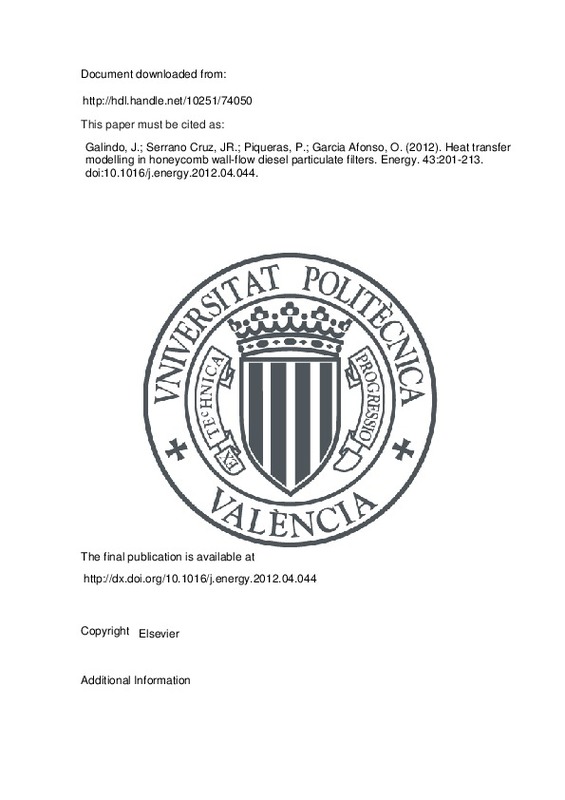Galindo, J.; Serrano Cruz, JR.; Piqueras, P.; García Afonso, Ó. (2012). Heat transfer modelling in honeycomb wall-flow diesel particulate filters. Energy. 43:201-213. https://doi.org/10.1016/j.energy.2012.04.044
Por favor, use este identificador para citar o enlazar este ítem: http://hdl.handle.net/10251/74050
|
Título:
|
Heat transfer modelling in honeycomb wall-flow diesel particulate filters
|
|
Autor:
|

 Galindo, José
Galindo, José

 Serrano Cruz, José Ramón
Serrano Cruz, José Ramón

 Piqueras, P.
García Afonso, Óscar
Piqueras, P.
García Afonso, Óscar
|
|
Entidad UPV:
|
Universitat Politècnica de València. Escuela Técnica Superior de Ingeniería del Diseño - Escola Tècnica Superior d'Enginyeria del Disseny
|
|
Fecha difusión:
|
|
|
Resumen:
|
Heat transfer in wall-flow monoliths has gained in interest because of the widespread adoption of these systems by automotive industry to fulfil soot emission regulations and the importance of heat exchange on the regeneration ...[+]
Heat transfer in wall-flow monoliths has gained in interest because of the widespread adoption of these systems by automotive industry to fulfil soot emission regulations and the importance of heat exchange on the regeneration process control to avoid damaging the monolith. This paper presents a heat transfer model for wall-flow diesel particulate filters coupled with an unsteady compressible flow solver. The heat exchange between the gas and the solid phase is based on a bi-dimensional discretisation of the porous medium both in axial and tangential directions. The monolith can be discretised in the radial direction to account for the heat fluxes towards the environment through the monolith and the canister, which is also coupled with the inlet and outlet ducts of the filter. The model is validated against experimental data obtained in a flow test rig. A test campaign under non-reacting conditions has been conducted to show the capability for thermal response prediction. Tests cover clean and soot loaded monolith, continuous flow under steady and transient thermal conditions, and pulsating flow. In this case, the characteristics of the pressure waves in amplitude and frequency are similar to those that the monolith can undergo depending on its location along the exhaust line. © 2012 Elsevier Ltd.
[-]
|
|
Palabras clave:
|
Aftertreatment
,
Diesel engines
,
Diesel particulate filter
,
Experiments
,
Heat transfer
,
Modelling
,
After-treatment
,
Continuous flows
,
Diesel particulate filters
,
Discretisation
,
Experimental data
,
Flow tests
,
Heat exchange
,
Heat transfer model
,
Heat transfer modelling
,
Outlet duct
,
Porous medium
,
Pressure waves
,
Pulsating flow
,
Radial direction
,
Regeneration process
,
Solid-phase
,
Soot emissions
,
Steady and transient
,
Tangential directions
,
Test campaign
,
Thermal response
,
Unsteady compressible flow
,
Wall-flow monoliths
,
Air filters
,
Automotive industry
,
Fuel filters
,
Heat exchangers
,
Porous materials
,
Soot
,
Wall flow
,
Monolithic integrated circuits
,
Compressible flow
,
Diesel engine
,
Equipment component
,
Exhaust emission
,
Experimental study
,
Filter
,
Flow pattern
,
Heat flux
,
Model validation
,
Numerical model
,
Particulate matter
,
Unsteady flow
|
|
Derechos de uso:
|
Reserva de todos los derechos
|
|
Fuente:
|
Energy. (issn:
0360-5442
)
|
|
DOI:
|
10.1016/j.energy.2012.04.044
|
|
Editorial:
|
Elsevier
|
|
Versión del editor:
|
http://dx.doi.org/10.1016/j.energy.2012.04.044
|
|
Código del Proyecto:
|
info:eu-repo/grantAgreement/MICINN//DPI2010-20891-C02-02/ES/ELABORACION DE MODELOS TERMOFLUIDODINAMICOS Y TECNICAS EXPERIMENTALES PARA DESARROLLAR UN COLECTOR DE ESCAPE MULTIFUNCIONAL CON UN FILTRO DE PARTICULAS DIESEL INTEGRADO/
|
|
Agradecimientos:
|
This work has been partially supported by the Spanish Ministerio de Ciencia e Innovacion through grant number DPI2010-20891-C02-02.
|
|
Tipo:
|
Artículo
|







![[Cerrado]](/themes/UPV/images/candado.png)




